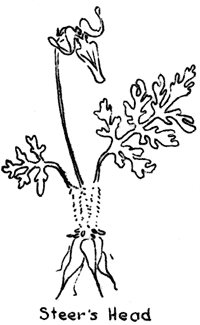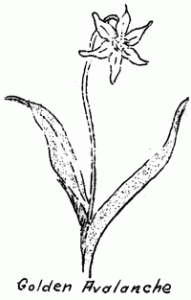Notes on Flowers
A most peculiar flower, which one may chance to see is the Steer’s Head (Dicentra uniflora Kell.) is now poking up its grotesque blossoms from the pumice slopes of Dutton Cliff and Applegate Peak. Its feathery green leaves, cut up into fine segments, offer a striking contrast to the flesh-colored blooms. It is very closely related to the common Wild Bleeding-hear or Dutchman’s Breeches(Dicentra formosa (Andr.) DC) which may be seen in moist places along the main roads.
Sun Meadows, situated in the glacial valley between Dutton Cliff and Applegate Peak, possesses one of the most beautiful displays of alpine flowers to be found in the Park. But now the snow still effectually delays any very luxuriant growth. However, there is one flower in bloom which is well worth taking trouble to see. This is the Yellow-flowered Lamb’s Tongue, or Dogtooth-violet,(Erythronium citrinum Wats. Parviflorum) which might better be called “Golden Avalanche Lily”, since it is a blood brother of the white Avalanche Lily of Mount Rainier. Each stem arises from a deep-seated, oval bulb, and bears a pair of dark green, lanceolate leaves and a single large golden flower. These hardy lilies spring up on every newly-exposed place, so that with retreating snow seems to leave its foot-prints in green and gold.
Many interested visitors inquire about the identity of the white-flowered, sweet-scented shrub that lines the main road into the park at lower elevations. It possesses broad, shiny leaves, which are mucilaginous on their lower surfaces. This plant has a bewildering variety of local and general common names: Deer-brush, Snow-brush, and Oregon Chapparral (Ceanothus valutinusDougl.) and is closely allied to the Mountain Lilac, or Blue-blossom, although neither are in any way related to the true Lilac, unless in outward appearance.
Along the trail to Garfield Peak, the trailside is blue from the wealth of flowers produced by the Mahalamata(Ceanothus prostratus Benth.). This is a prostrate shrub, with leaves resembling those of holly, which produces great masses of small blue or lilac flowers.
Crater Lake Dogwood
By D. S. Libbey
Last fall the Dogwood trees along the highway approaches to Crater Lake were in bloom. Again as we came up about the middle of June we found the Dogwood in blossom. Often the question is asked, why call a tree such a homely name? This is the explanation given by the Pennsylvania Department of Forests: “A very astringent concoction used to be stripped from the Dogwood and used to wash mangy dogs. That is how the tree got its name. The bark of the flowering Dogwood yields quinine.”



